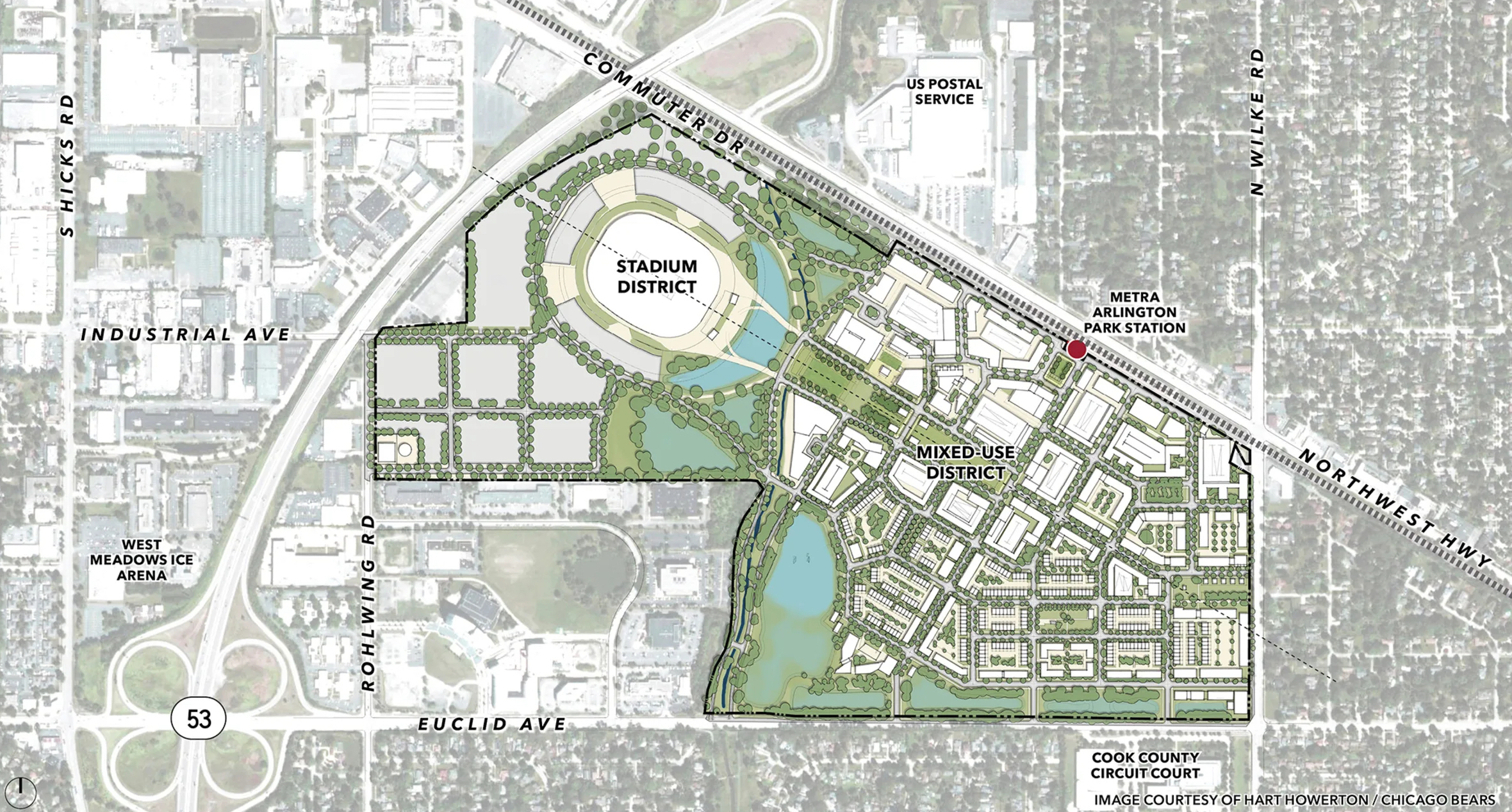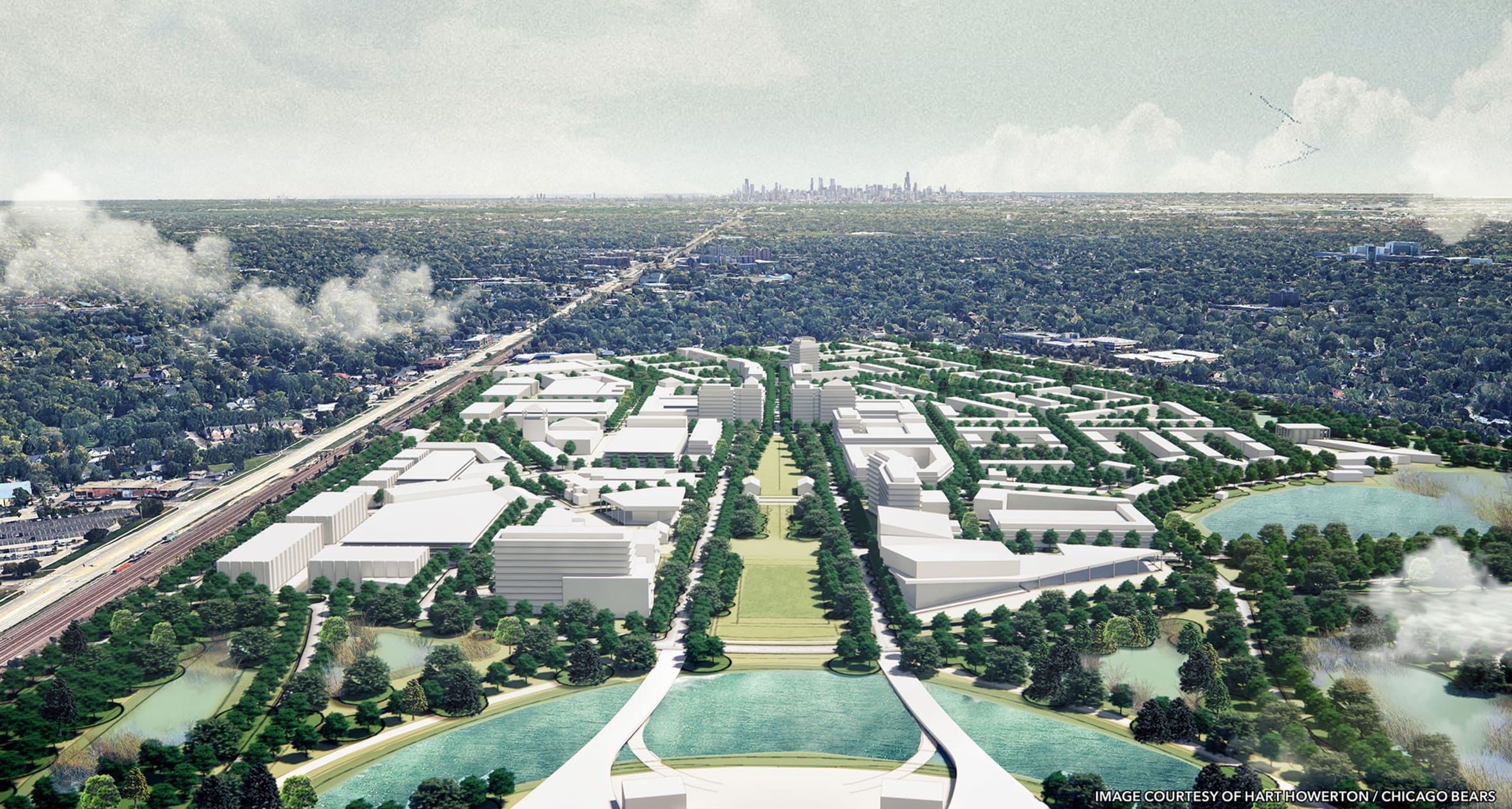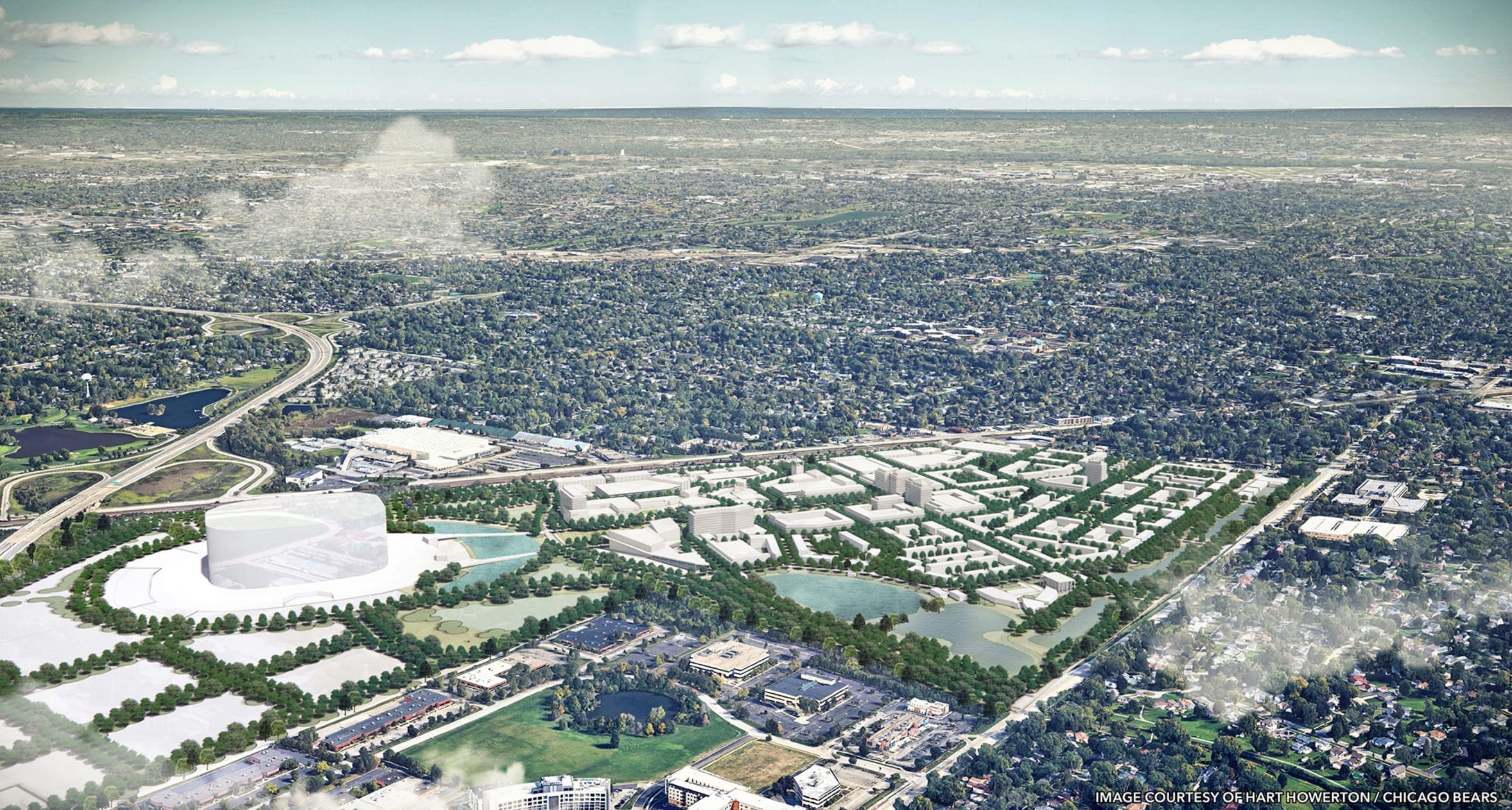As the 2022 NFL season kicks off, one of the league’s original franchises is solidifying plans to leave its landmark lakefront stadium for a multi-billion-dollar mixed-use stadium district in northwest suburban Arlington Heights, Ill.
The Chicago Bears, on Tuesday, released renderings that depict a preliminary master plan for the 326-acre property, the former home of the Arlington International Racecourse. The team, last September, signed a $197.2 million agreement to purchase the land from Churchill Downs Inc. The Bears have yet to close on the property.
The prelim master plan, by architecture firm Hart Howerton, features a 206-acre transit-oriented entertainment and mixed-use district situated on the southeast half of the property, with the 120-acre stadium district on the west side. Water features, tree-lined walking paths, and greenery separate the two districts. Initial plans call for multifamily residential, restaurants, bars, a hotel, and commercial/retail components, with walking access to the stadium and the existing Metra Arlington Park train station.
In an open letter to the public posted on Tuesday, Bears officials unveiled their vision for the project: “a multi-purpose entertainment district anchored by a new, best-in-class enclosed stadium, providing Chicagoland with a new home worthy of hosting global events such as the Super Bowl, College Football Playoffs, and Final Four.” In the same letter, the team noted that the property deal is not yet a sure thing, and that “there are conditions that must be met in order to be in a position to close,” and: “If we do close on the property, it does not guarantee we will develop it.”

In the meantime, the team has cut off discussions with the city of Chicago related to renovating Soldier Field, even as city officials push for a possible deal to keep the Bears in Chicago. In July, the city, in partnership with a development team, released three design concepts for upgrading Soldier Field, including a domed stadium plan that would cost $2 billion.
The Bears, in the open letter, stated that while under contract with Churchill Downs, the team would not explore alternative stadium sites or opportunities. In short, while a deal is not 100% certain, it appears more likely that the Bears will be packing their bags for Arlington Heights within the next decade.
Why would the Chicago Bears leave Chicago?
There are several motivations for leaving Chicago. For one, the Bears do not own Soldier Field; the city does. Under the current Soldier Field contract, which runs through 2033, the franchise must share sizable revenues with the city and must rely on the Chicago Park District for maintenance of the property. Field conditions have been an ongoing issue for the team and NFL league officials, as have event schedule conflicts, parking capacity, accessibility, the overall fan experience.
Secondly, with a capacity of just 61,500, Soldier Field is the smallest stadium in the NFL, with nearly 20,000 fewer seats than Dallas Cowboys’ AT&T Stadium and 21,000 fewer seats than MetLife Stadium, home of the New York Giants and Jets.
ALSO SEE: Chicago proposes three options for Soldier Field renovation including domed stadium
The biggest motivation, perhaps, is the unrealized revenue potential for one of the world’s most valuable sports franchises ($5.8 billion, No. 6 on Forbes’ World’s 50 Most Valuable Sports Teams 2022). The Bears have watched other sports organizations—Atlanta Braves, Chicago Cubs, Green Bay Packers, Milwaukee Bucks, to name a few—cash in on private and public-private sports-anchored entertainment districts that draw year-round crowds and create a more diverse revenue model.

Who’s going to pay for the Chicago Bears stadium?
According to the Bears, its Arlington Heights plan would not call for public funding for direct stadium structure construction. The organization left open the possibility of seeking public funds to assist with the development of the other portions of the development.
The team believes that any public investment is money well spent given the short-term and ongoing benefit to the Chicagoland community, Cook County, and the state of Illinois. The Bears stated: “Construction of the proposed project is projected to create more than 48,000 jobs, result in $9.4 billion in economic impact for Chicagoland, and provide $3.9 billion in labor income to workers across the region, while the completed project will create more than 9,750 long-term jobs, result in $1.4 billion in annual economic impact for Chicagoland and provide $601 million in annual labor income to workers across Chicagoland. We also anticipate that the development will generate $16 million in annual tax revenue in addition to property taxes for Arlington Heights, $9.8 million for Cook County, and $51.3 million for the State of Illinois.”
Related Stories
| Aug 11, 2010
Dream Fields, Lone Star Style
How important are athletic programs to U.S. school districts? Here's one leading indicator: In 2005, the National Football League sold 17 million tickets. That same year, America's high schools sold an estimated 225 million tickets to football games, according to the American Football Coaches Association.
| Aug 11, 2010
Giants 300 University Report
University construction spending is 13% higher than a year ago—mostly for residence halls and infrastructure on public campuses—and is expected to slip less than 5% over the next two years. However, the value of starts dropped about 10% in recent months and will not return to the 2007–08 peak for about two years.
| Aug 11, 2010
Nurturing the Community
The best seat in the house at the new Seahawks Stadium in Seattle isn't on the 50-yard line. It's in the southeast corner, at the very top of the upper bowl. "From there you have a corner-to-corner view of the field and an inspiring grasp of the surrounding city," says Kelly Kerns, project leader with architect/engineer Ellerbe Becket, Kansas City, Mo.
| Aug 11, 2010
Financial Wizardry Builds a Community
At 69 square miles, Vineland is New Jersey's largest city, at least in geographic area, and it has a rich history. It was established in 1861 as a planned community (well before there were such things) by the utopian Charles Landis. It was in Vineland that Dr. Thomas Welch found a way to preserve grape juice without fermenting it, creating a wine substitute for church use (the town was dry).
| Aug 11, 2010
Integrated Project Delivery builds a brave, new BIM world
Three-dimensional information, such as that provided by building information modeling, allows all members of the Building Team to visualize the many components of a project and how they work together. BIM and other 3D tools convey the idea and intent of the designer to the entire Building Team and lay the groundwork for integrated project delivery.
| Aug 11, 2010
Bronze Award: Alumni Gymnasium Renovation, Dartmouth College Hanover, N.H.
At a time when institutions of higher learning are spending tens of millions of dollars erecting massive, cutting-edge recreation and fitness centers, Dartmouth College in Hanover, N.H., decided to take a more modest, historical approach. Instead of building an ultra-grand new facility, the university chose to breathe new life into its landmark Alumni Gymnasium by transforming the outdated 99-y...







